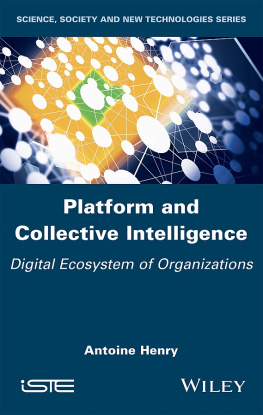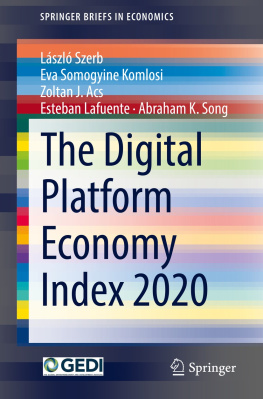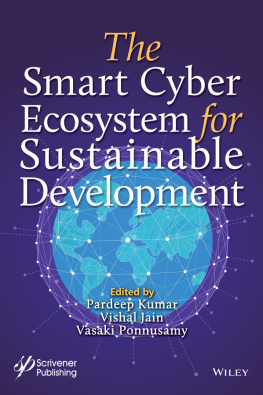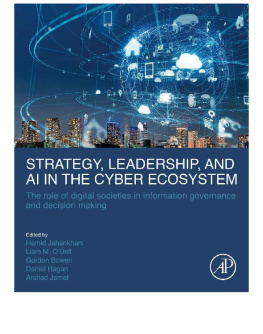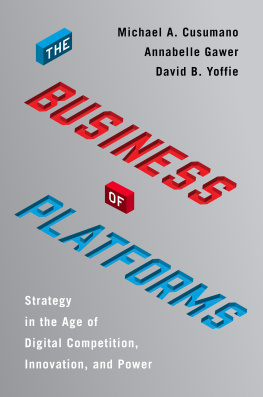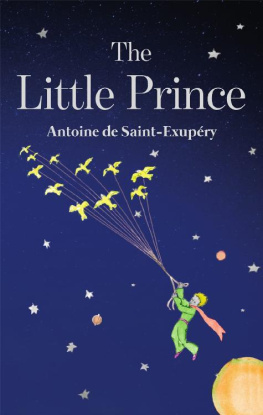Henry Antoine - Platform and Collective Intelligence: Digital Ecosystem of Organizations
Here you can read online Henry Antoine - Platform and Collective Intelligence: Digital Ecosystem of Organizations full text of the book (entire story) in english for free. Download pdf and epub, get meaning, cover and reviews about this ebook. year: 2020, genre: Romance novel. Description of the work, (preface) as well as reviews are available. Best literature library LitArk.com created for fans of good reading and offers a wide selection of genres:
Romance novel
Science fiction
Adventure
Detective
Science
History
Home and family
Prose
Art
Politics
Computer
Non-fiction
Religion
Business
Children
Humor
Choose a favorite category and find really read worthwhile books. Enjoy immersion in the world of imagination, feel the emotions of the characters or learn something new for yourself, make an fascinating discovery.
- Book:Platform and Collective Intelligence: Digital Ecosystem of Organizations
- Author:
- Genre:
- Year:2020
- Rating:4 / 5
- Favourites:Add to favourites
- Your mark:
- 80
- 1
- 2
- 3
- 4
- 5
Platform and Collective Intelligence: Digital Ecosystem of Organizations: summary, description and annotation
We offer to read an annotation, description, summary or preface (depends on what the author of the book "Platform and Collective Intelligence: Digital Ecosystem of Organizations" wrote himself). If you haven't found the necessary information about the book — write in the comments, we will try to find it.
Henry Antoine: author's other books
Who wrote Platform and Collective Intelligence: Digital Ecosystem of Organizations? Find out the surname, the name of the author of the book and a list of all author's works by series.
Platform and Collective Intelligence: Digital Ecosystem of Organizations — read online for free the complete book (whole text) full work
Below is the text of the book, divided by pages. System saving the place of the last page read, allows you to conveniently read the book "Platform and Collective Intelligence: Digital Ecosystem of Organizations" online for free, without having to search again every time where you left off. Put a bookmark, and you can go to the page where you finished reading at any time.
Font size:
Interval:
Bookmark:

Series Editor
Fabrice Papy
Antoine Henry

First published 2021 in Great Britain and the United States by ISTE Ltd and John Wiley & Sons, Inc.
Apart from any fair dealing for the purposes of research or private study, or criticism or review, as permitted under the Copyright, Designs and Patents Act 1988, this publication may only be reproduced, stored or transmitted, in any form or by any means, with the prior permission in writing of the publishers, or in the case of reprographic reproduction in accordance with the terms and licenses issued by the CLA. Enquiries concerning reproduction outside these terms should be sent to the publishers at the undermentioned address:
ISTE Ltd
27-37 St Georges Road
London SW19 4EU
UK
www.iste.co.uk
John Wiley & Sons, Inc.
111 River Street
Hoboken, NJ 07030
USA
www.wiley.com
ISTE Ltd 2021
The rights of Antoine Henry to be identified as the author of this work have been asserted by him in accordance with the Copyright, Designs and Patents Act 1988.
Library of Congress Control Number: 2020946598
British Library Cataloguing-in-Publication Data
A CIP record for this book is available from the British Library
ISBN 978-1-78630-492-6
The scientific work and research that concerns organizations has grown considerably in recent years. This is due to the polarization of human activities within structures whose projects and vocations are extremely diverse. It is then as many pluriverses and plurivocal processes that coexist, function and interact locally, globally and even glocally in the multitude of these existing organizations and social structures whose legal and managerial form often remains conventional (Svensson 2001; Batazzi-Alexis 2002; Eberhard 2013; Koop 2018). Moreover, this polarization in organizations has spread with the unifying framework represented by the information society (IS), which has been further aggravated by the intensification of the economic dimension in contemporary societies (Ahrne and Brunsson 2005). This recent context has exacerbated the place of organizations, identified as atomic entities through which, and within which, a wide range of the multiplicity of human activities is expressed. The complexity of these agencies, which are being developed on a planetary scale with the explosion of international economic transactions, explains why the organizations are studied by a wide variety of disciplines and scientific fields that are often complementary: management sciences, economics, information technology, law, commerce, sociology, anthropology, social psychology, ethnology, and information and communication sciences (Geslin 2002; Bernard 2004).
It is clear that todays organizations, which have risen to the new information society, much to the delight of political and economic forces, bear witness to a new complexity engendered by a heterogeneous set of structures whose boundaries have become more flexible and whose communication processes have become intertwined. These structures increasingly interact through an increase in self-emerging cross-cutting collaborative activities and processes (El Amrani 2008). This complexity surpasses the binary categorization used until recently, distinguishing according to a trivial typology between private and public entities: the former are generally associated with the world of business, trade and industry, and the latter with the institutional and governmental world in its national or international declinations (such as the UN, UNESCO, ISO and WHO) (Bouillon 2005; Bernard 2016), both evolving until now in an implicitly recognized territorialization.
The massive penetration of information and communication technologies (ICTs) in all spheres of human activities and the unprecedented expansion of digitally mediated communications have completely reshuffled the maps and functional boundaries of these basic types of organizations built on a common hierarchical decision-making model. An unprecedented complexity has emerged, which is driven by the immediate concentric and/or eccentric influences propagated by the dissemination and sharing of natively digital information. Concentric influences emanate from outside the organization and intrude, either voluntarily or accidentally, into the internal processes of organizations outside the usual and regulated channels of information dissemination. Eccentric influences, on the other hand, are those that an organization exerts on the outside, voluntarily or accidentally, through the same technological channels for disseminating and sharing information, as well as outside the usual and regulated circuits defined by the organization. This sudden porosity of an informational and communicational nature of the clear boundary that recently separated the inside of an organization from the outside, has come about with the massive adoption and exploitation of these computer technologies specific to the Internet, the Web of Documents and the Social Web (Navarro 2001; Gardey 2003; Greenan and Mairesse 2006; Hochereau 2006; Walkowiak 2006).
The technological tools, inspired by the Internet and the early Web (Web 1.0), which became widespread in all organizations, from the smallest to the largest multinationals, brought much more than operational comfort to organizations. Previously, their decision-makers were worried about the inevitable time to upgrade their IT systems, given the impact in terms of cost, reorganization of practices and training of staff, and were not at ease with the procedures for re-computing, upsizing or migrating their information systems (Botta-Genoulaz 2007; Legrenzi 2015; Besson 2016).
The widespread use of Web technologies, supported by the World Wide Web Consortium and its powerful members, has definitively dispelled doubts about the operational efficiency, robustness, scalability and adaptability of these digital technologies (Papy and Sansonetti 2014). Major technological achievements such as YouTube, Amazon, Instagram, Twitter and Facebook, in their respective economic registers, retain their leadership role and, through their technological and economic performance, support the technological architectures on which their success was built. These extraordinary digital devices, via their platform marketplace with a global audience, drive a large part of the worlds economic activities and are also the broadcasters/recipients of a considerable proportion of online digital traffic. These spectacular technological and economic successes are now inspiring the most recent platforming projects, to which all private and public organizations are committed, whatever their scope of action. It is still the same digital technologies that are being mobilized and acclaimed, contributing to the increase, if there was still a need, of their trust capital.
Thus, the performative efficiency of Web technologies and their rapid acceptability, both by the technical teams that implement them and by the users who have to integrate them into their work processes, have determined the decision-makers and information technology departments of these organizations to adopt these technologies, which have been instrumental for two decades now in the Web of Documents, the Web of Data, the Semantic Web, the Social Web and the Commercial Web.
The deployment of Web technologies within organizations is now confirmed and applies, through specific applications, to all processes essential to the operation of organizations: administrative, accounting, logistics, commercial and industrial. However, this deployment is not insignificant (Hnnocque 2002; Rifkin 2002; Balpe
Next pageFont size:
Interval:
Bookmark:
Similar books «Platform and Collective Intelligence: Digital Ecosystem of Organizations»
Look at similar books to Platform and Collective Intelligence: Digital Ecosystem of Organizations. We have selected literature similar in name and meaning in the hope of providing readers with more options to find new, interesting, not yet read works.
Discussion, reviews of the book Platform and Collective Intelligence: Digital Ecosystem of Organizations and just readers' own opinions. Leave your comments, write what you think about the work, its meaning or the main characters. Specify what exactly you liked and what you didn't like, and why you think so.

